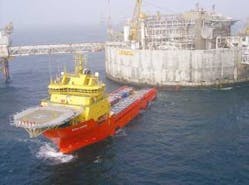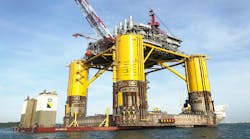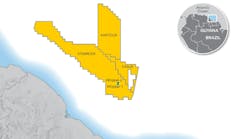Nick Terdre
Contributing Editor
After years of planning, ConocoPhillips has finally begun abandonment of the Ekofisk tank on its flagship field in the Norwegian sector of the North Sea. Cleaning of the tank's storage cells is under way, and a contractor has been chosen to remove the topsides, starting next year.
Surrounded by its protective barrier, the Ekofisk tank, 2/4 T , stands like a colossus at the center of the Ekofisk platform complex. Installed in 1973 in a water depth of around 75 m, it was the first offshore installation with a concrete gravity base. The latter is 90 m high and 89 m in diameter, and weighs 290,000 tonnes.
The base consists of nine storage cells surrounded by the original breakwater wall. This wall is itself surrounded by a protective barrier, 140 m in diameter and weighing 900,000 tonnes, which was put in place in 1989 to shield the platform from the effects of seabed subsidence. The topsides, which were assembled through myriad lifting operations offshore, comprises 88 modules, vessels, and in-fill structures weighing 24,000-26,000 tonnes.
The tank served initially for crude storage only. But when the oil export pipeline to the UK came into operation in 1975, the storage cells were instead used for separating hydrocarbons from produced water. Production from the outlying fields in the Ekofisk area was processed on the topsides. Operations on the platform ceased in 1998, and it was put into a cold state.
A decade later, as the decommissioning plan for 15 redundant platforms in the greater Ekofisk area was being drawn up, Phillips acknowledged that it was the tank that represented the most formidable challenge. The licensees recommended that the topsides be removed and the base left in place, fitted with navigational aids. The member countries of the Ospar convention raised no objections, and in 2002, Norway's parliament gave its app-roval for the proposal.
Before it can be abandoned, the tank has to put into a condition in which it will do no harm to the environment. In addition to the topsides removal, two main tasks have to be carried out. The storage cells have to be cleaned, and sediments lying at the bottom of the inner and outer annuli have to be covered. These annuli are respectively the spaces between the storage cells and the breakwater, and between the breakwater and the protective barrier.
null
Cleaning the cells is not straightforward. It involves significant technical and safety challenges. The cells are filled with water, on the surface of which floats a layer of oily wax half a meter thick. At the base of each cell is a layer of contaminated sediments up to 1 m thick. The water cannot simply be pumped out, as this would threaten the integrity of the walls.
Access to the cells is basically via piping that is only 70 cm in diameter.
The clean-up job was awarded early this year to Aker Kværner Offshore Partner (AKOP), after a front-end engineering design competition involving three contractors. For safety reasons, the first step in abandoning the tank had to be treatment of the water to remove the high content of hydrogen sulfide ( H2S) in the water phase – up to 1,000 ppm, according to Kristian K Andreasen, project manager for the tank cleaning.
The water was treated with sodium chloride to remove the H2S. Nitrate was added to the sodium chloride to stimulate the creation of nitrate-reducing bacteria at the expense of sulfate-reducing bacteria, thus inhibiting the formation of further H2S. Eventually H2S may form again, but not before the topside removal operations are completed, according to Andreasen.
Some research was required to determine how the chemicals should be added to the water to ensure effective mixing. Simply injecting the chemicals into the water would not ensure an adequate distribution through the whole water column. The solution was to inject the chemicals into each cell via a manifold system. Satisfactory diffusion was achieved by using special injection nozzles and submerged circulation pumps.
The offshore pumping operation took only 1.5 days, using the Edda Fjord supply boat equipped with external tanks and a pumping system on the deck. During the process, 2,150 tonnes of sodium chloride and 450 tonnes of nitrate were pumped into the tanks. To accommodate these chemicals, the equivalent volume of water had to be withdrawn. This was discharged into a fiberglass tank on the platform, where it was also subjected to anti- H2S treatment.
The process worked rapidly, says Andreasen. After 12 hours, it was possible to tell from the water being discharged that the H2S content was diminishing in line with expectations. Following treatment, the water could be discharged into the sea.
ConocoPhillips has a discharge permit allowing discharge from the Norwegian Pollution Control Authority (SFT). This is required because some of the water will indeed be discharged into the sea, as it is necessary to lower the water level in the cells by 7 m to allow the further stages of the cleanup to proceed. At this time, nitrogen will be pumped into the gap at the top of the cells to act as an inert gas and prevent the risk of explosion.
The risk exists because there is some H2S content and also hydrocarbon gases in the wax. For this reason H2S detectors have been permanently installed in the cells and all working areas.
The next phase of tank cleaning gets under way in mid-September and is expected to continue through the 1Q 2005. Two operations will be carried out – first the wax will be skimmed from the surface of the water, then the sediments will be removed from the tanks by suction.
In June and July, the equipment for these operations was being tested. Pump specialist Frank Mohn has designed and built both the skimming tool and the sediment retrieval tool. Both tools are designed to suck up 50 cu m/hr, though this will also include water – in the case of the sediments, water is expected to account for 90% of the material retrieved. The skimmer tool is a floating unit with thrusters. The wax it collects will first go through a cutting unit before being pumped out of the cell.
null
The sediments and the wax will be treated in a process plant in which they will be separated from the water – this equipment was also tested in June. Designed and built by AKOP's subcontractor Reime Process, the plant uses a flocculation process and band filters to achieve separation. The principle is widely applied in onshore sewage treatment but is new to the offshore industry, Andreasen points out. To deal with any H2S remaining in the wax and sediments, scavengers will be added at the pump inlet.
The wax could contain up to 30% solids, which would be unsuitable for injection into the production stream. Instead both the wax and the sediments will be pumped down a disposal well on the Ekofisk 2/4 X platform.
A team of about 20 will carry out these operations. All the personnel will undergo special training, not least to ensure that safety remains uppermost in everyone's mind, as this is an overriding consideration at all stages of the tank abandonment. The Norwegian research institute Sintef has been engaged to run activities aimed at developing the safety culture both for the tank-cleaning project and for the topsides removal.
Andreasen notes the lengthy period devoted to planning and preparations, though the actual phase of offshore work is relatively short. Mobilization of the Edda Fjord for the H2S treatment lasted for 10 days, though the treatment operation itself took only a day and a half. "We want to be sure that when we go offshore we do it right," he says. "We're using technology which is known but has not been applied before in this context."
Topsides removal is scheduled to get under way around mid-2005. Offshore operations, which will involve a team of 40-45 personnel, are expected to take about two years to complete, though onshore disposal work will carry on into 2008. Six companies competed for the contract, offering a variety of methods: a conventional heavy-lift crane-barge, a platform-mounted crane, and the piece-small method. All the bidders had previously carried out front end engineering design work, and ConocoPhillips was satisfied that all the proposed methods were feasible, according to Kari Amundsen, project manager for the Ekofisk Cessation project.
On the basis of an overall evaluation of cost, safety, technical, and environmental considerations, AF Decom was adjudged to have made the best bid, and in February it was awarded a contract worth approximately NKr400 million. The contractor has extensive experience of demolishing onshore plant, including the former Shell refinery outside Stavanger, but has not previously worked offshore. It will employ the piece-small method, cutting up the topside structures with hydraulic scissors into pieces small enough to be loaded into containers and dispatched to shore by supply boat. The pace of work is expected to generate one shipload per week.
This approach will not necessarily take more time than the more conventional heavy-lift method, though the latter would allow the removal of larger sections. But in some ways it is a safer method, says Amundsen. One of the risks associated with the many lifting operations is that of structural damage due to dropped objects, but AF Decom will use a method whereby the excavators with hydraulic scissors work in pairs, one holding the object at all times. For smaller items, dropped object protection is used. Personnel are at all times protected inside the excavator. Project Manager Asbjørn Olsen and his team have a strong focus on this, and the company has a good safety record, she says.
Before cutting gets under way, front-runners will scour all parts of the topsides to locate and deal with hazardous and non-metallic materials, which will be removed before the excavators start cutting. The materials are known to include asbestos, which has been used in some walls and may be present elsewhere, for example in piping insulation. The extent to which other hazardous materials may be present is not known.
null
No major equipment sales are expected from the demolished structures returned to shore, but reusable materials such as copper are expected to be recovered and sold. The steel, which accounts for the bulk of the topsides weight, will be recycled.
Compared with the tank cleaning and topsides removal, dealing with the sediments within the annuli is a straightforward job. In 2008, once the other operations have been completed, they will be covered with sand and gravel. The platform will then be fitted with navigational aids and permanently abandoned, though periodic visits will be made to check on the condition of the aids and the water in the cells.
To some degree, the Ekofisk team has been able to learn from previous experience. Useful contacts have been held with Shell personnel involved in the Brent spar disposal, who also had to treat the water in the storage tanks for H2S. The recent decommissioning of Phillips' Maureen platform, a steel gravity-base structure in the UKCS featuring three large storage tanks, was also relevant.
The Ekofisk tank is the first of the concrete gravity-base platforms in the North Sea to be decommissioned, and ConocoPhillips' experiences will be noted by owners of other concrete platforms in the sector.
A valuable contribution in the process of developing decommissioning methods for the tank has come from a five-strong international scientific review group appointed by ConocoPhillips, Amundsen says. Regulatory authorities have also been closely involved, notably the SFT on pollution issues and the Petroleum Safety Authority Norway on the HSE side. Other stakeholders, including fishing associations and environmental NGOs, have been kept regularly informed and consulted.
On Ekofisk ConocoPhillips is in a unique situation in that it is implementing further stages of development at the same time as it is abandoning some of the facilities. In August, it was due to install the steel jacket for a new wellhead platform, Ekofisk 2/4 M, on which 25 new wells will be drilled, as well as starting pre-qualification for the removal of other redundant platforms,.
A contract will be awarded in the first half of 2005 for the removal of light structures such as bridges, flares, and tripods. A year later a contract will be awarded for the removal of five-six platforms. An option will be attached to this contract for the removal of a further four platforms plus the 2/4 Q topsides. The deadline for completing these operations is 2013, by which time further new platforms will have been installed on the field.








